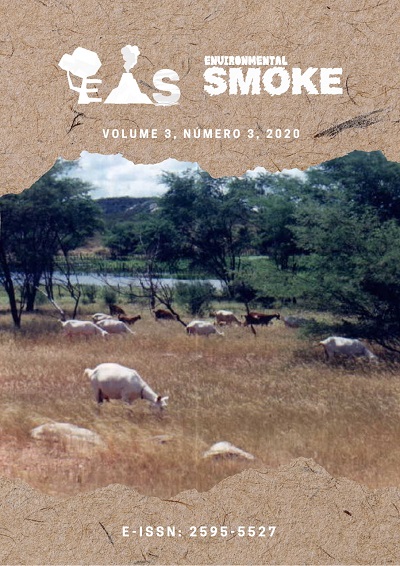PASTURES, SOIL AND COMPOSTING. LITERATURE REVIEW
DOI:
https://doi.org/10.32435/envsmoke.20203301-06Palavras-chave:
Alternative technologies, Management of organic waste, Pasture improvementResumo
The Veterinarian must be aware of the pastures and their handling, as the high quality pastures will contribute to an excellent nutrition of the animals. Within this logic, soil is an essential natural resource for the survival of animals, since ecosystems contribute to the growth of plants and to the regulation of water flow in the environment, functioning as an environmental buffer, in the formation, attenuation and degradation of compounds natural. Composting is the process of controlled degradation of organic waste, which is a process in which it seeks to reproduce ideal conditions of humidity, oxygen and nutrients, especially carbon and nitrogen, to favor and accelerate the degradation of waste in a safe manner, avoiding the attraction of disease vectors and eliminating pathogens. Thus, knowing these environmental contributions, will favor in the guidelines that the veterinarian should pass on to the country man, aiming to have a well-nourished herd and with consequent lesser animal convalescence.Downloads
Referências
ARAÚJO, N.H. Avaliação de produção de composto a partir de algas marinhas arribadas como alternativa para adubação de hortaliças. Dissertação (Mestrado em Desenvolvimento de Meio Ambiente) - Universidade Federal da Paraíba. 67 p. 2016.
BASTOS, L.A.G.; SILVA, M.C.B.C.; FURTADO, G.D. Compostagem de algas arribadas como ferramenta de Educação Ambiental em uma escola pública. Revista Brasileira de Educação Ambiental, Diadema, v. 14, n. 1, p. 416-438, 2019.
BASTOS, L.A.G.; FURTADO, G.D. Uso de algas arribadas (sargaço) para produção de adubo por meio de compostagem como ferramenta de educação ambiental numa escola pública do município de Cabedelo-PB. Educação Ambiental em Ação, Novo Hamburgo, v. 16, n. 1, p. 1-4, 2017.
BATISTA, C.C.N.; MOURA, E.J.B.; SANTOS, G.D.; FURTADO, G.D.; RIBEIRO, L.F.C.; HAGERAATS, R.M. Compostagem doméstica: desafios e possibilidades ao gerenciamento de resíduos orgânicos do lar. Educação Ambiental em Ação, Novo Hamburgo, v. 15, n. 4, p. 1-6, 2016.
BERTONI, J.; LOMBARDI NETO, F. Conservação do solo. São Paulo: Ícone. 2014.
CHIODEROLI, C.A.; MELLO, L.M.M; GRIGOLLI, P.J.; FURLANI, C.E.A.; SILVA, J.O.R.; CESARIN, A.L. Atributos físicos do solo e produtividade de soja em sistema de consórcio milho e braquiária. Revista Brasileira de Engenharia Agrícola e Ambiental, Campina Grande, v. 16, n. 1, p. 37-43, 2012.
FURTADO, G.D.; FERREIRA, E.G.; COSTA, D.A.; ARAÚJO, N.H.; SILVA, F.A. Experiência com a prática de compostagem em comunidade pesqueira da praia da Penha-PB. Revista de Ciências da Saúde Nova Esperança, João Pessoa, v. 15, n. 2, p. 21-26, 2017.
GODOI, C.R.; SILVA, E.F.P. A pastagem como forma de conservação do solo. PUBVET, Londrina, v. 4, n. 14, ed. 119, Art. 806, 2010.
MMA. Ministério do Meio Ambiente. Compostagem doméstica, comunitária e institucional de resíduos orgânicos: manual de orientação. Brasília, DF. p. 68. 2018.
OLIVEIRA, A.N.; OLIVEIRA, A.N.; SILVA, K.R.; SILVA, J.A.; MELLO, A.H. Atributos químicos de solos sob diferentes sistemas de uso e manejo no Projeto de Assentamento Veneza- São Domingos do Araguaia. Agroecossistemas, Belém, v. 9, n. 1, p. 170-179, 2017.
PEDREIRA, B.C.; PEREIRA, L.E.T.; PAIVA, A.J. Eficiência produtiva e econômica na utilização de pastagens adubadas. II SIMBOV – Simpósio Matogrossense de Bovinocultura de Corte, UFMT. 2013.
SILVA, D.M.A. Apostila de forragicultura e pastagens destinada ao Curso Técnico de Nível Médio em Agropecuária das Escolas Estaduais de Educação Profissional – EEEP. Fortaleza - CE, 2018.
SOARES FILHO, C.V.; CECATO, U.; RIBEIRO, O.L.; ROMA, C.F.C.; JOBIM, C.C.; BELONI, T.; PERRI, S.H.V. Sistema radicular e reservas orgânicas de raízes e base do colmo do capim Tanzânia fertilizado com doses de nitrogênio sob pastejo. Semina: Ciências Agrárias, Londrina, v. 34, n. 5, p. 2415-2426, 2013.
Downloads
Publicado
Como Citar
Edição
Seção
Licença
The copyright for manuscripts published in Environmental Smoke belongs to the author, with first publication rights for the journal. The published articles are of total and exclusive responsibility of the authors.






























































